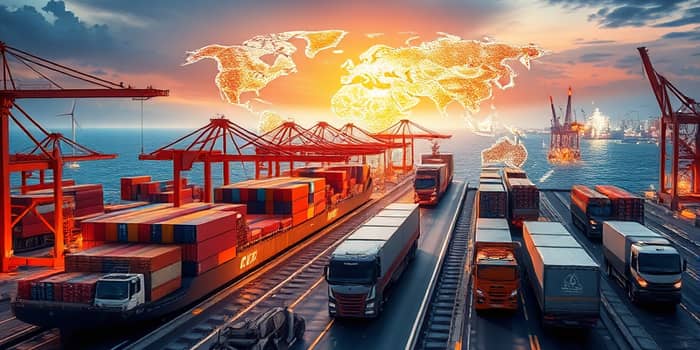
Over the past century, cycles of soaring commodity prices have reshaped economies, trade patterns, and strategic alliances. Today’s world stands on the cusp of a new supercycle, with both promise and peril for exporters.
Commodity supercycles are prolonged, decades-long periods where prices remain consistently above or below historical averages, typically lasting 15–20 years. These extended cycles drive transformative shifts in production, investment, and trade across the globe.
These supercycles feature distinct boom and bust phases: during the boom, prices climb, output scales up, and profits pour in; then oversupply triggers a bust, and prices plummet, leaving markets in turmoil.
The 20th century witnessed four major supercycles, each sparked by pivotal global events. Early industrialization in the United States surged demand for coal and steel, while pre-World War II rearmament drove metals and oil consumption. Later, post-war reconstruction and globalization fueled another upswing, culminating in China’s WTO accession in 2001.
Most recently, the early 2000s supercycle was marked by China’s meteoric rise: iron ore, copper, and oil exports from Brazil, Australia, and Russia soared. Beyond Asia’s growth, global population expansion and rising middle-class consumption have compounded demand for essential raw materials.
When prices surge, commodity-exporting nations experience export revenues surge dramatically, enabling investment in infrastructure, social programs, and sovereign wealth funds. High prices tilt terms of trade move in favor of resource-rich countries, creating newfound bargaining power in diplomatic and economic negotiations.
Yet the bust phase often inflicts deep wounds: projects launched in boom times add to oversupply, prolonging downturns. Nations lacking resilience suffer sharp economic contractions, and recovery can stretch over a decade.
The last major commodity price supercycle, which began in 1996 and peaked in 2011, spanned 15 years. During that interval, global commodity export values more than doubled. Today, the US shale boom—accounting for nearly 90% of new oil supply in the past decade—is tapering, raising questions about future American export capacity.
Meanwhile, the clean energy transition is redefining demand profiles. Metals such as lithium, cobalt, and copper have entered a new phase of price appreciation as electric vehicles, solar arrays, and wind farms proliferate. Analysts project that energy transition minerals could outperform fossil fuels in export growth over the next supercycle.
The cyclicality of commodity markets underscores the importance of robust policy design. Governments can mitigate downside risks by establishing stabilization funds and savings reserves, anchoring public spending to long-term price averages rather than erratic spot values. Crafting fiscal budgets that anticipate downturns allows for counter-cyclical budgeting practices that smooth out revenue volatility.
These measures should be complemented by investment in education, infrastructure, and institutional capacity, ensuring that resource wealth translates into long-term fiscal resilience and equitable social development.
As the world pursues decarbonization, clean energy demand has emerged as the defining factor for the next commodity supercycle. Traditional fossil fuel exporters must adapt or risk decline, while nations rich in transition metals stand to gain unprecedented advantages.
Governments and corporations are already ramping up exploration and production of key elements like lithium, nickel, and rare earths. At the same time, environmental, social, and governance (ESG) standards are reorienting capital flows, making it imperative for exporters to demonstrate sustainable practices. Aligning with global climate goals can unlock premium markets and long-term contracts.
Export dependence on a narrow set of commodities heightens vulnerability to price shocks. Diversification—both sectoral and geographic—allows countries to spread risk across multiple industries and markets. For instance, combining mineral exports with agribusiness and light manufacturing can balance cyclical swings.
Moreover, new trade alliances are reshaping global commerce. South-South cooperation between Latin America, Africa, and Asia has intensified, creating alternative channels beyond traditional Western markets. By forging regional partnerships and participating in trading blocs, nations can leverage shared expertise and collective bargaining power.
Commodity supercycles are powerful forces that alter export dynamics, redistribute economic power, and transform geopolitical landscapes. While booms bring prosperity, busts can leave lasting scars. The challenge for policymakers and business leaders is to harness the upswing while fortifying economies against the downturn.
By implementing solid economic diversification strategies, establishing stabilization mechanisms, and embracing the clean energy transition, commodity-rich countries can build a sustainable path forward. The new supercycle beckons with opportunities for those prepared to adapt, innovate, and collaborate on a truly global scale.
Ultimately, success in the coming decades will depend on vision and vigilance: understanding market cycles, anticipating structural shifts, and aligning export strategies with emerging industrial revolutions. In this dynamic era, resilient leaders will transform natural wealth into enduring prosperity for generations to come.
References













